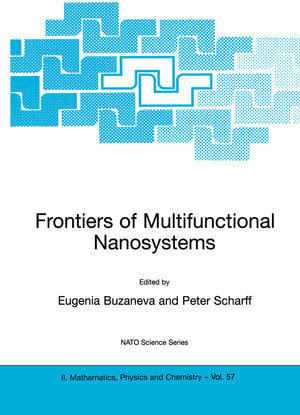
×
![Buchcover ISBN 9789401003414]()
Inhaltsverzeichnis
- Multiscale computer simulations in physics, chemistry and biology: the example of silica.
- Application of the IMOMM (Integrated Molecular Orbital Molecular Mechanics) method for biopolymers.
- Molecular orbital simulation of semiconductor and metal cluster.
- Modeling and interpretation of STM images of carbon nanosystems.
- Carbon nanotubes under internal pressure.
- Recognition templates for biomaterials with engineered bioreactivity.
- Layer-by-layer method for immobilization of protein molecules on biochip surface.
- Enzyme electrodes with enzyme immobilised by sol-gel technique.
- Template-directed lattices of nanostructures: preparation and physical properties.
- Templates for metal nanowire self-assembly.
- Layer-by-layer assembly of nanotubes and nanofilms from nanoparticle and polymer blocks for electronic applications.
- Non-thermal plasma synthesis of nanocarbons.
- A novel network structure of organometallic clusters in gas phase.
- Nanotechnology of DNA/nano-Si and DNA/Carbon nanotubes/nano-Si chips.
- Fundamental properties and applications of fullerene and carbon nanotube systems.
- Fundamental properties of DNA: some lessons from studies on the molecular basis of drug binding.
- DNA modifications by novel antitumor platinum drugs.
- Studies on protein electron carrier complexes: adrenodoxin reductase-adrenodoxin complex in steroid biosynthesis.
- Interaction of nucleic acids and lipids from tumour cells with anticancer drugs: an SEIRA spectroscopy data.
- Aggregation of fullerenes in pyridine/water solutions.
- Infrared spectrum of fullerene C60 aggregates in water solution.
- Electrical and magnetic properties of undoped fullerene polymers.
- Direct transition in the porous nanosilicon measured by electroreflectance.
- Scanning probe microscopy of biomacromolecules: nucleicacids, proteins and their complexes.
- Application of atomic force microscopy in protein and DNA biochips development.
- Peculiarities of Th. Terrestris spores surface ultrastructure investigated by AFM.
- Relaxation of nanostructured molecular materials under the influence of solvent vapors.
- Biospecific interactions on the optical transducer surface - the base of infection diagnostics.
- Thin film biotermosensors.
- Porous silicon as transducer for immune sensors: from theory to practices.
- A porous silicon microcavity as an optical and electrical multiparametric chemical sensor.
- Composites silicon-based photonic crystals as light emission and sensor elements.
- Optical transmission of macroporous silicon.
- Magnetoresistive sensors and memory.
- The electron spin in nanoelectronics.
- List of Participants.



